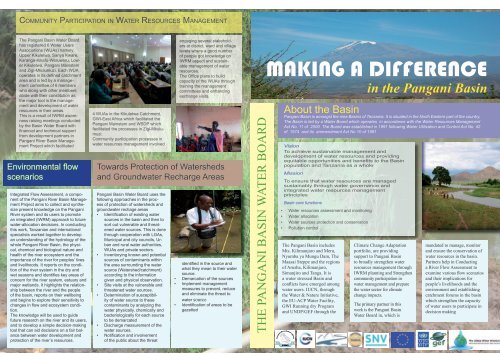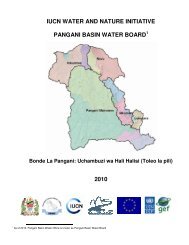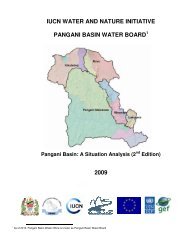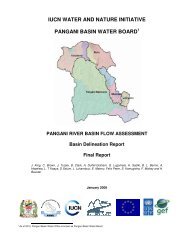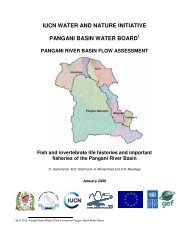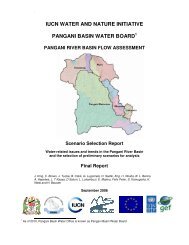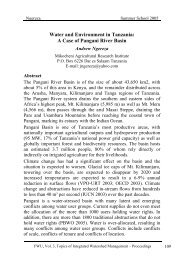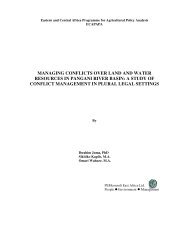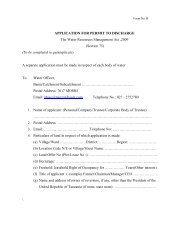MAKING A DIFFERENCE - Pangani Basin Water Board
MAKING A DIFFERENCE - Pangani Basin Water Board
MAKING A DIFFERENCE - Pangani Basin Water Board
You also want an ePaper? Increase the reach of your titles
YUMPU automatically turns print PDFs into web optimized ePapers that Google loves.
community participation in <strong>Water</strong> Resources Management<br />
The <strong>Pangani</strong> <strong>Basin</strong> <strong>Water</strong> <strong>Board</strong><br />
has registered 6 <strong>Water</strong> Users<br />
Associations (WUAs) namely<br />
Upper Kikuletwa, Sanya Kware,<br />
Karanga-Kikafu-Weruweru, Lower<br />
Kikuletwa, <strong>Pangani</strong> Mainstem<br />
and Zigi-Mkulumuzi. Each WUA<br />
operates in its defined catchment<br />
area and is led by a management<br />
committee of 6 members<br />
who along with other members<br />
abide with their constitution as<br />
the major tool in the management<br />
and development of water<br />
resources in their areas.<br />
This is a result of IWRM awareness<br />
raising meetings conducted<br />
by the <strong>Basin</strong> <strong>Water</strong> <strong>Board</strong> with<br />
financial and technical support<br />
from development partners in<br />
<strong>Pangani</strong> River <strong>Basin</strong> Management<br />
Project which facilitated<br />
Environmental flow<br />
scenarios<br />
Integrated Flow Assessment, a component<br />
of the <strong>Pangani</strong> River <strong>Basin</strong> Management<br />
Project aims to collect and synthesize<br />
present knowledge on the <strong>Pangani</strong><br />
River system and its users to promote<br />
an integrated (IWRM) approach to future<br />
water-allocation decisions. In conducting<br />
this work, Tanzanian and international<br />
specialists worked together to develop<br />
an understanding of the hydrology of the<br />
whole <strong>Pangani</strong> River <strong>Basin</strong>, the physical,<br />
chemical and biological nature and<br />
health of the river ecosystem and the<br />
importance of the river for peoples’ lives<br />
and livelihoods. It reports on the condition<br />
of the river system in the dry and<br />
wet seasons and identifies key areas of<br />
concern for the river system, estuary and<br />
major wetlands. It highlights the relationship<br />
between the river and the people<br />
of the basin, reports on their wellbeing<br />
and begins to explore their sensitivity to<br />
changes in flow and ecosystem condition.<br />
The knowledge will be used to guide<br />
future research on the river and its users,<br />
and to develop a simple decision-making<br />
tool that can aid decisions on a fair balance<br />
between water development and<br />
protection of the river’s resources.<br />
4 WUAs in the Kikuletwa Catchment,<br />
GWI-East Africa which facilitated the<br />
<strong>Pangani</strong> Mainstem and WSDP which<br />
facilitated the processes in Zigi-Mkulumuzi.<br />
Community participation processes in<br />
water resources management involved<br />
engaging several stakeholders<br />
at district, ward and village<br />
levels where a good number<br />
of people got knowledge on<br />
IWRM aspect and sustainable<br />
management of water<br />
resources.<br />
The Office plans to build<br />
capacity of the WUAs through<br />
training the management<br />
committees and enhancing<br />
exchange visits.<br />
Towards Protection of <strong>Water</strong>sheds<br />
and Groundwater Recharge Areas<br />
<strong>Pangani</strong> <strong>Basin</strong> <strong>Water</strong> <strong>Board</strong> uses the<br />
following approaches in the process<br />
of protection of watersheds and<br />
groundwater rechage areas<br />
• Identification of existing water<br />
sources in the basin and then to<br />
sort out vulnerable and threatened<br />
water sources. This is done<br />
through cooperation with LGAs,<br />
Municipal and city councils, Urban<br />
and rural water authorities,<br />
WUAs and private sectors.<br />
• Inventorying known and potential<br />
sources of contaminants within<br />
the area surrounding the water<br />
source (<strong>Water</strong>shed/catchment)<br />
according to the information<br />
given and physical observation.<br />
• Site visits at the vulnerable and<br />
threatened water sources.<br />
• Determination of susceptibility<br />
of water source to these<br />
contaminants by analyzing the<br />
water physically, chemically and<br />
bacteriologically for each source<br />
to be demarcated<br />
• Discharge measurement of the<br />
water sources.<br />
• Notification and involvement<br />
of the public about the threat<br />
identified in the source and<br />
what they mean to their water<br />
source.<br />
• Demarcation of the sources<br />
• Implement management<br />
measures to prevent, reduce<br />
and eliminate the threat to<br />
water source<br />
• Identification of areas to be<br />
gazetted<br />
The <strong>Pangani</strong> <strong>Basin</strong> <strong>Water</strong> <strong>Board</strong><br />
<strong>MAKING</strong> A <strong>DIFFERENCE</strong><br />
in the <strong>Pangani</strong> <strong>Basin</strong><br />
About the <strong>Basin</strong><br />
<strong>Pangani</strong> <strong>Basin</strong> is amongst the nine <strong>Basin</strong>s of Tanzania. It is situated in the North Eastern part of the country.<br />
The <strong>Basin</strong> is led by a <strong>Water</strong> <strong>Board</strong> which operates in accordance with the <strong>Water</strong> Resources Management<br />
Act No. 11 of 2009. The <strong>Board</strong> was established in 1991 following <strong>Water</strong> Utilization and Control Act No. 42<br />
of 1974 and its ammendment Act No 10 of 1981<br />
Vision<br />
To achieve sustainable management and<br />
development of water resources and providing<br />
equitable opportunities and benefits to the <strong>Basin</strong><br />
population and Tanzania as a whole<br />
Mission<br />
To ensure that water resources are managed<br />
sustainably through water governance and<br />
integrated water resources management<br />
principles<br />
<strong>Basin</strong> core functions<br />
• <strong>Water</strong> resources assessment and monitoring<br />
• <strong>Water</strong> allocation<br />
• <strong>Water</strong> sources protection and conservation<br />
• Pollution control<br />
The <strong>Pangani</strong> <strong>Basin</strong> includes<br />
Mts. Kilimanjaro and Meru,<br />
Nyumba ya Mungu Dam, The<br />
Maasai Steppe and the regions<br />
of Arusha, Kilimanjaro,<br />
Simanjiro and Tanga. It is<br />
a water stressed <strong>Basin</strong> and<br />
conflicts have emerged among<br />
water users. IUCN, through<br />
the <strong>Water</strong> & Nature Initiative,<br />
the EU-ACP <strong>Water</strong> Facility,<br />
GWI Running dry Program<br />
and UNDP/GEF through the<br />
Climate Change Adaptation<br />
portfolio, are providing<br />
support to <strong>Pangani</strong> <strong>Basin</strong><br />
to broadly strengthen water<br />
resources management through<br />
IWRM planning and Strengthen<br />
community participation in<br />
water management and prepare<br />
the water sector for climate<br />
change impacts.<br />
The primary partner in this<br />
work is the <strong>Pangani</strong> <strong>Basin</strong><br />
<strong>Water</strong> <strong>Board</strong> in, which is<br />
mandated to manage, monitor<br />
and ensure the conservation of<br />
water resources in the basin.<br />
Partners help in Conducting<br />
a River Flow Assessment to<br />
examine various flow scenarios<br />
and their implications for<br />
people’s livelihoods and the<br />
environment and establishing<br />
catchment forums in the basin<br />
which strengthen the capacity<br />
of water users to participate in<br />
decision making
Calendar of Events<br />
Developing an IWRMD plan for <strong>Pangani</strong> <strong>Basin</strong><br />
January, 2011<br />
Environment Safeguard Training<br />
Workshop, Morogoro<br />
4th - 6th February, 2011<br />
Chago Wetland Conservation Meeting<br />
Same.<br />
9th February, 2011<br />
CCDP Meeting<br />
Lusaka, Zambia<br />
18th February, 2011<br />
21st Partners Meeting<br />
PBWO, Moshi<br />
22nd to 26th February, 2011<br />
Inhouse Training of WUAs Management<br />
Committees<br />
Arusha<br />
28th February to 5th March, 2011<br />
Field Visit by WUAs in<br />
<strong>Pangani</strong> <strong>Basin</strong><br />
7th to 8th March,2011<br />
GWI Project Mgt Team Meeting<br />
Moshi<br />
10th to 12th March, 2011<br />
2nd Chago Wetland Conservation<br />
Meeting<br />
Same<br />
14th to 17th March, 2011<br />
Monitoring and Evaluation Workshop,<br />
Arusha<br />
15th - 17th March, 2011<br />
GWI Proposal design Workshop, Moshi<br />
23rd March, 2011<br />
LGA Feedback Meetings on WUA<br />
Moshi<br />
24th March, 2011<br />
LGA Feedback Meetings on WUA<br />
Hai<br />
28th March, 2011<br />
LGA Feedback Meetings on WUA<br />
Arusha<br />
29th March, 2011<br />
LGA Feedback Meetings on WUA<br />
Simanjiro<br />
31st March -2nd April,2011<br />
Website Training, Moshi<br />
30th March -3rd April, 2011<br />
GIS Training, Moshi<br />
5th April, 2011<br />
WUAs Launching, Arusha<br />
5th - 6th April, 2011<br />
ELAN Workshop on CC<br />
Dar es Salaam<br />
7th - 8th April, 2011<br />
Seminars for Law Enforcement<br />
Officers<br />
11th - 14th April, 2011<br />
Workshop on CC scenarios<br />
Capetown, South Africa<br />
Integrated <strong>Water</strong> Resources<br />
Management and<br />
Development Plan<br />
<strong>Pangani</strong> <strong>Basin</strong> <strong>Water</strong> <strong>Board</strong><br />
plans to procure a consultant<br />
to support preparation of<br />
IWRM and development plans.<br />
ToR and EoI for design of IWRM<br />
and Dev. plans for the <strong>Basin</strong> have<br />
been issued and evaluated.6 firms<br />
out of 36 were shortlisted and<br />
RFPs were issued on 16th Dec,<br />
2010 and deadline was set to<br />
22nd Feb, 2011 but it is extended<br />
to 11th Mar, 2011. The plan<br />
will help mainstream IWRM in<br />
sectoral plans in the water sector<br />
and ensure sustainable water<br />
resources management<br />
Community<br />
story<br />
The <strong>Pangani</strong> <strong>Basin</strong> <strong>Water</strong><br />
<strong>Board</strong> and IUCN through the<br />
Global <strong>Water</strong> Initiative, has<br />
supported the construction of<br />
a cattle trough in Ruvu, Same<br />
District which is in an extremely<br />
dry area of Tanzania where the<br />
majority of the population are<br />
pastoralists. Onesmo Zakaria,<br />
with the IUCN <strong>Pangani</strong> Project<br />
Office interviewed seventy<br />
years old, Maasai elder, Mzee<br />
Laisi Mkaine. Mkane is thankful<br />
to the donor and the partners<br />
involved in implementing the<br />
GWI Program, he thanked<br />
the donor and implementing<br />
partner for their commitment<br />
to fulfill an important priority<br />
for the community – “I have<br />
seen a huge difference<br />
between this new cattle<br />
trough and our traditional troughs”.<br />
Mkaine mentions three major<br />
differences between traditional troughs<br />
and the new GWI aided cattle trough,<br />
“our traditional troughs can only take<br />
10 cows per phase, it takes a lot of<br />
time for communities to re-dig every<br />
after a rain comes and furthermore<br />
it jeopardizes lives of animals and<br />
headsman mostly youth (Morans)<br />
when it often collapses. We have<br />
been told and we can also see by<br />
ourselves that the new modern trough<br />
can serve 100 cattle per phase and is<br />
free from other hazards I mentioned”.<br />
Mzee Mkaine is very optimistic of the<br />
sustainability of the trough, “I have<br />
once visited Mkandi in Mnazi, Lushoto<br />
district where I witnessed a cattle<br />
trough which was constructed way<br />
back in 1965 and it is still intact and<br />
serves the purpose as ever before<br />
despite some small challenges such<br />
as increased number of animals”.<br />
In a closing remark, Mkaine calls<br />
upon the initiative and other actors to<br />
find a way of helping the community<br />
in their initiative to replace the hand<br />
pump by appropriate technology that<br />
can fill the already constructed tank<br />
to acquire fruitful objectives of the<br />
trough. He says, “We were promised<br />
by the district about the installment<br />
of the pump that will go concurrently<br />
with the construction of the dipping<br />
trough in the vicinity. However,<br />
the community has learned that<br />
the trough will be ready before the<br />
construction of the dipping trough<br />
and the pump installation. As a<br />
result we have mobilized ourselves<br />
so each pastoralist contributes<br />
TShs 5,000 (700,000 already in<br />
custody) to install the pump”. This<br />
financial input shows continued<br />
commitment from the community.<br />
Along with Mzee Laisi the community<br />
at Ruvu Jiungeni (Kombo Sub)<br />
Village proposes the construction<br />
of a windmill to pump water from<br />
a nearby borehole which will<br />
have a minimum running cost.<br />
The Global <strong>Water</strong> Initiative (GWI)<br />
is funded by Howard G. Buffet<br />
Foundation has the aim of ‘ensuring<br />
that vulnerable populations worldwide<br />
have reliable access to clean<br />
water in such a way that their<br />
dignity, rights, culture and natural<br />
environment are not negatively<br />
impacted’. In Tanzania, the GWI<br />
partnership consists of CARE,<br />
Catholic Relief Services and IUCN.<br />
Story by Onesmo Zakaria (IUCN,<br />
2009)


